Korea choson dynasty 1392 1910 Stock Photos and Images
(45)See korea choson dynasty 1392 1910 stock video clipsQuick filters:
Korea choson dynasty 1392 1910 Stock Photos and Images
 Wrapping Cloth (pojagi), Choson dynasty (1392–1910), 19th century, Korea, Korea, Silk, eighty-one pieced squares, outer edge, and backing, ribbons of plain gauze weave self-patterned by areas of plain weave, squares joined with silk in overcast stitches, edging joined with silk in back stitches, ribbon embellished with silk, plain weave tapes, 66.7 x 67 cm (26 3/8 x 26 3/8 in Stock Photohttps://www.alamy.com/image-license-details/?v=1https://www.alamy.com/wrapping-cloth-pojagi-choson-dynasty-13921910-19th-century-korea-korea-silk-eighty-one-pieced-squares-outer-edge-and-backing-ribbons-of-plain-gauze-weave-self-patterned-by-areas-of-plain-weave-squares-joined-with-silk-in-overcast-stitches-edging-joined-with-silk-in-back-stitches-ribbon-embellished-with-silk-plain-weave-tapes-667-x-67-cm-26-38-x-26-38-in-image328658910.html
Wrapping Cloth (pojagi), Choson dynasty (1392–1910), 19th century, Korea, Korea, Silk, eighty-one pieced squares, outer edge, and backing, ribbons of plain gauze weave self-patterned by areas of plain weave, squares joined with silk in overcast stitches, edging joined with silk in back stitches, ribbon embellished with silk, plain weave tapes, 66.7 x 67 cm (26 3/8 x 26 3/8 in Stock Photohttps://www.alamy.com/image-license-details/?v=1https://www.alamy.com/wrapping-cloth-pojagi-choson-dynasty-13921910-19th-century-korea-korea-silk-eighty-one-pieced-squares-outer-edge-and-backing-ribbons-of-plain-gauze-weave-self-patterned-by-areas-of-plain-weave-squares-joined-with-silk-in-overcast-stitches-edging-joined-with-silk-in-back-stitches-ribbon-embellished-with-silk-plain-weave-tapes-667-x-67-cm-26-38-x-26-38-in-image328658910.htmlRM2A2KKP6–Wrapping Cloth (pojagi), Choson dynasty (1392–1910), 19th century, Korea, Korea, Silk, eighty-one pieced squares, outer edge, and backing, ribbons of plain gauze weave self-patterned by areas of plain weave, squares joined with silk in overcast stitches, edging joined with silk in back stitches, ribbon embellished with silk, plain weave tapes, 66.7 x 67 cm (26 3/8 x 26 3/8 in
 Korea: Atlas of the World ('Ch'ŏnha chido') showing China, the 'Middle Kingdom', as the centre of the world, 17th century This Ch'ŏnha chido ('Map Of All Under Heaven') was produced in Korea in the 17th century, a copy of a traditional Korean atlas produced in the early Choson Dynasty (1392-1910). The structure of the map is simple. A main continent, containing China, Korea and a number of historically known countries occupies the centre of the circular map, surrounded by an enclosing sea ring, which is itself surrounded by an outer ring of land. Stock Photohttps://www.alamy.com/image-license-details/?v=1https://www.alamy.com/korea-atlas-of-the-world-chnha-chido-showing-china-the-middle-kingdom-as-the-centre-of-the-world-17th-century-this-chnha-chido-map-of-all-under-heaven-was-produced-in-korea-in-the-17th-century-a-copy-of-a-traditional-korean-atlas-produced-in-the-early-choson-dynasty-1392-1910-the-structure-of-the-map-is-simple-a-main-continent-containing-china-korea-and-a-number-of-historically-known-countries-occupies-the-centre-of-the-circular-map-surrounded-by-an-enclosing-sea-ring-which-is-itself-surrounded-by-an-outer-ring-of-land-image344251725.html
Korea: Atlas of the World ('Ch'ŏnha chido') showing China, the 'Middle Kingdom', as the centre of the world, 17th century This Ch'ŏnha chido ('Map Of All Under Heaven') was produced in Korea in the 17th century, a copy of a traditional Korean atlas produced in the early Choson Dynasty (1392-1910). The structure of the map is simple. A main continent, containing China, Korea and a number of historically known countries occupies the centre of the circular map, surrounded by an enclosing sea ring, which is itself surrounded by an outer ring of land. Stock Photohttps://www.alamy.com/image-license-details/?v=1https://www.alamy.com/korea-atlas-of-the-world-chnha-chido-showing-china-the-middle-kingdom-as-the-centre-of-the-world-17th-century-this-chnha-chido-map-of-all-under-heaven-was-produced-in-korea-in-the-17th-century-a-copy-of-a-traditional-korean-atlas-produced-in-the-early-choson-dynasty-1392-1910-the-structure-of-the-map-is-simple-a-main-continent-containing-china-korea-and-a-number-of-historically-known-countries-occupies-the-centre-of-the-circular-map-surrounded-by-an-enclosing-sea-ring-which-is-itself-surrounded-by-an-outer-ring-of-land-image344251725.htmlRM2B020GD–Korea: Atlas of the World ('Ch'ŏnha chido') showing China, the 'Middle Kingdom', as the centre of the world, 17th century This Ch'ŏnha chido ('Map Of All Under Heaven') was produced in Korea in the 17th century, a copy of a traditional Korean atlas produced in the early Choson Dynasty (1392-1910). The structure of the map is simple. A main continent, containing China, Korea and a number of historically known countries occupies the centre of the circular map, surrounded by an enclosing sea ring, which is itself surrounded by an outer ring of land.
 Ball, Korea, Choson dynasty (1392-1910), 19th century. Stock Photohttps://www.alamy.com/image-license-details/?v=1https://www.alamy.com/ball-korea-choson-dynasty-1392-1910-19th-century-image466983182.html
Ball, Korea, Choson dynasty (1392-1910), 19th century. Stock Photohttps://www.alamy.com/image-license-details/?v=1https://www.alamy.com/ball-korea-choson-dynasty-1392-1910-19th-century-image466983182.htmlRM2J3MWPP–Ball, Korea, Choson dynasty (1392-1910), 19th century.
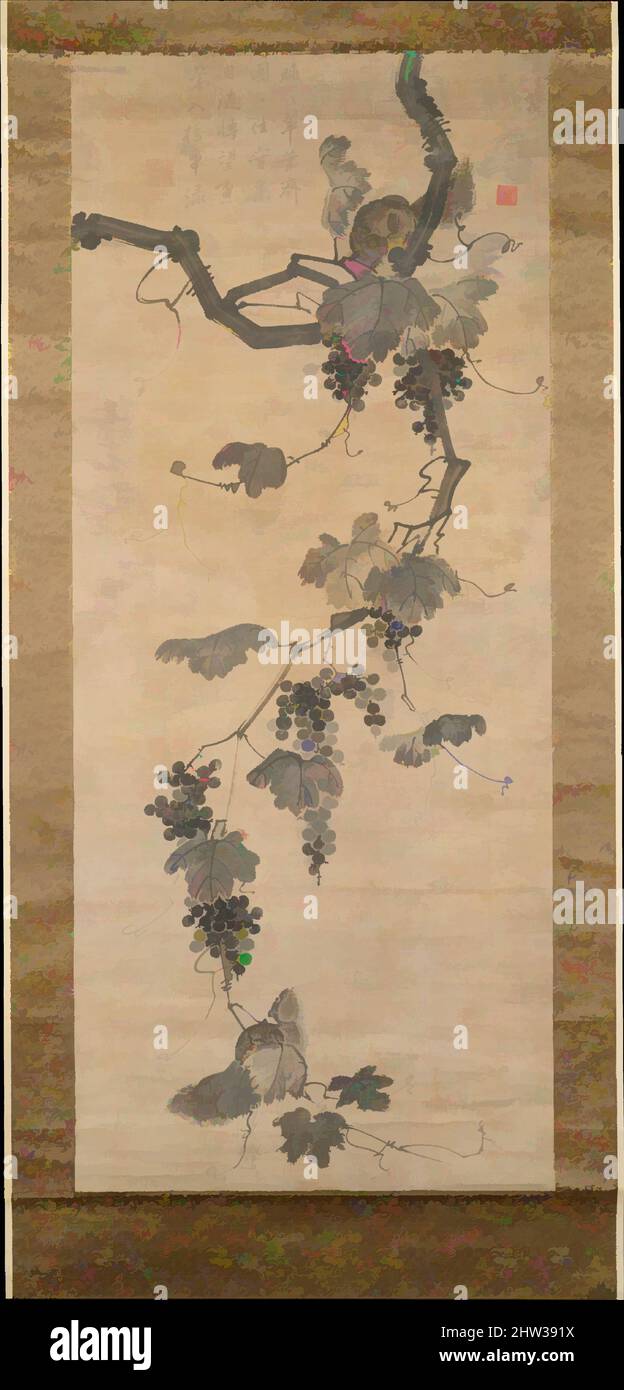 Art inspired by Grapevine and Squirrels, Joseon dynasty (1392–1910), early 19th century, Korea, Hanging scroll; ink and color on paper, Image: 54 x 22 3/4 in. (137.2 x 57.8 cm), Paintings, Unidentified Artist, The subject of grapevine rendered in ink was popular among literati painters, Classic works modernized by Artotop with a splash of modernity. Shapes, color and value, eye-catching visual impact on art. Emotions through freedom of artworks in a contemporary way. A timeless message pursuing a wildly creative new direction. Artists turning to the digital medium and creating the Artotop NFT Stock Photohttps://www.alamy.com/image-license-details/?v=1https://www.alamy.com/art-inspired-by-grapevine-and-squirrels-joseon-dynasty-13921910-early-19th-century-korea-hanging-scroll-ink-and-color-on-paper-image-54-x-22-34-in-1372-x-578-cm-paintings-unidentified-artist-the-subject-of-grapevine-rendered-in-ink-was-popular-among-literati-painters-classic-works-modernized-by-artotop-with-a-splash-of-modernity-shapes-color-and-value-eye-catching-visual-impact-on-art-emotions-through-freedom-of-artworks-in-a-contemporary-way-a-timeless-message-pursuing-a-wildly-creative-new-direction-artists-turning-to-the-digital-medium-and-creating-the-artotop-nft-image462908934.html
Art inspired by Grapevine and Squirrels, Joseon dynasty (1392–1910), early 19th century, Korea, Hanging scroll; ink and color on paper, Image: 54 x 22 3/4 in. (137.2 x 57.8 cm), Paintings, Unidentified Artist, The subject of grapevine rendered in ink was popular among literati painters, Classic works modernized by Artotop with a splash of modernity. Shapes, color and value, eye-catching visual impact on art. Emotions through freedom of artworks in a contemporary way. A timeless message pursuing a wildly creative new direction. Artists turning to the digital medium and creating the Artotop NFT Stock Photohttps://www.alamy.com/image-license-details/?v=1https://www.alamy.com/art-inspired-by-grapevine-and-squirrels-joseon-dynasty-13921910-early-19th-century-korea-hanging-scroll-ink-and-color-on-paper-image-54-x-22-34-in-1372-x-578-cm-paintings-unidentified-artist-the-subject-of-grapevine-rendered-in-ink-was-popular-among-literati-painters-classic-works-modernized-by-artotop-with-a-splash-of-modernity-shapes-color-and-value-eye-catching-visual-impact-on-art-emotions-through-freedom-of-artworks-in-a-contemporary-way-a-timeless-message-pursuing-a-wildly-creative-new-direction-artists-turning-to-the-digital-medium-and-creating-the-artotop-nft-image462908934.htmlRF2HW391X–Art inspired by Grapevine and Squirrels, Joseon dynasty (1392–1910), early 19th century, Korea, Hanging scroll; ink and color on paper, Image: 54 x 22 3/4 in. (137.2 x 57.8 cm), Paintings, Unidentified Artist, The subject of grapevine rendered in ink was popular among literati painters, Classic works modernized by Artotop with a splash of modernity. Shapes, color and value, eye-catching visual impact on art. Emotions through freedom of artworks in a contemporary way. A timeless message pursuing a wildly creative new direction. Artists turning to the digital medium and creating the Artotop NFT
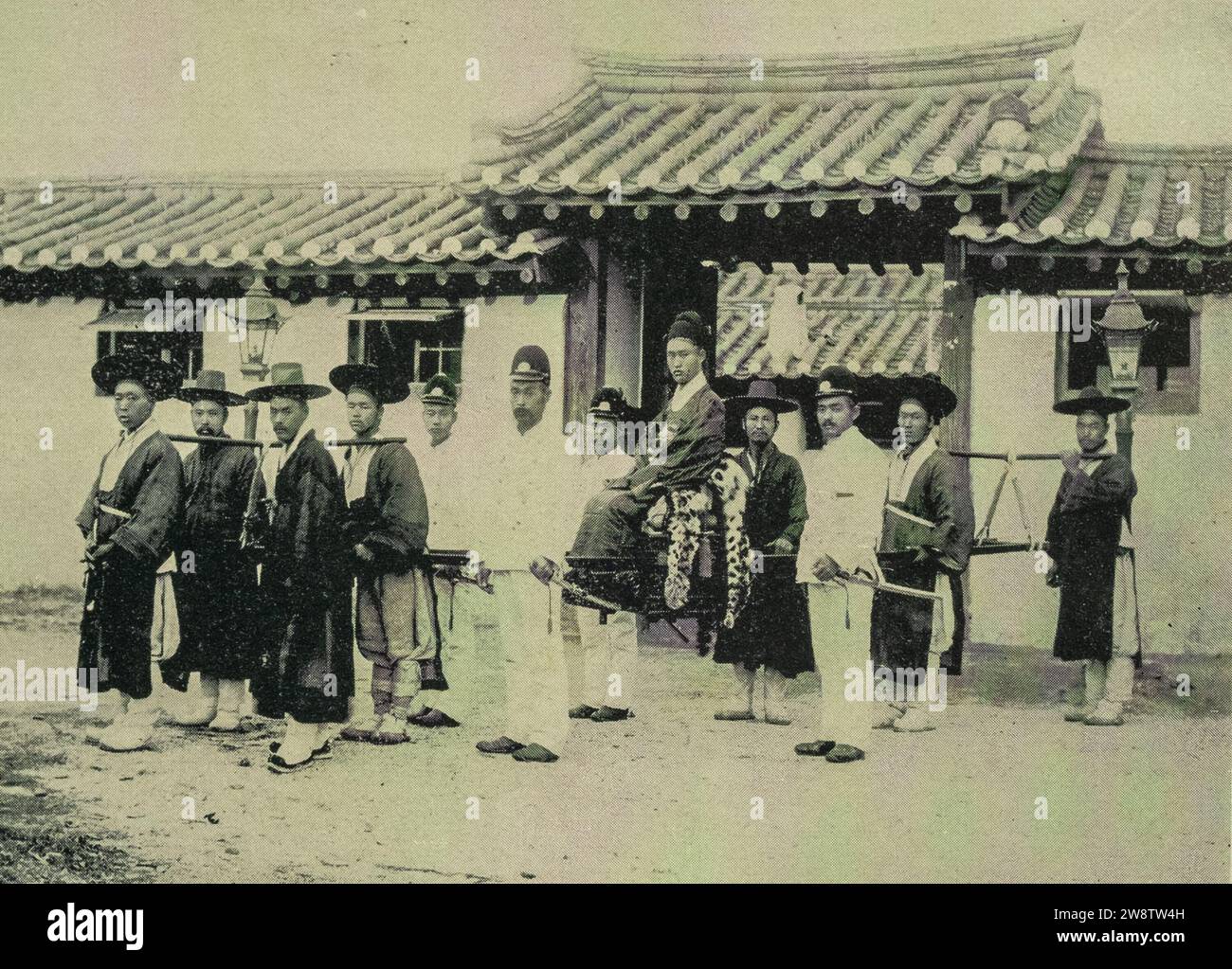 Korean Yangban and his servants in late Joseon Period (1392-1897). Yangban, (Korean: “two groups”), the highest social class of the Joseon Dynasty (1392–1910) of Korea. Stock Photohttps://www.alamy.com/image-license-details/?v=1https://www.alamy.com/korean-yangban-and-his-servants-in-late-joseon-period-1392-1897-yangban-korean-two-groups-the-highest-social-class-of-the-joseon-dynasty-13921910-of-korea-image590616337.html
Korean Yangban and his servants in late Joseon Period (1392-1897). Yangban, (Korean: “two groups”), the highest social class of the Joseon Dynasty (1392–1910) of Korea. Stock Photohttps://www.alamy.com/image-license-details/?v=1https://www.alamy.com/korean-yangban-and-his-servants-in-late-joseon-period-1392-1897-yangban-korean-two-groups-the-highest-social-class-of-the-joseon-dynasty-13921910-of-korea-image590616337.htmlRM2W8TW4H–Korean Yangban and his servants in late Joseon Period (1392-1897). Yangban, (Korean: “two groups”), the highest social class of the Joseon Dynasty (1392–1910) of Korea.
 . 임진왜란 때의 의병활동으로 유명하신 스님이자, 한국 불교사에 뚜렷한 흔적을 남기신 분인 서산대사의 초상화 (청허당)Portrait of Seosan Daesa (Cheongheodang, 1520–1604), Chosôn dynasty (1392–1910), Hanging scroll, ink and color on silk; 152.1 x 77.8 cm, National Museum of Korea . Joseon Dynasty. Unidentifed artist. 774 Korea-Joseon-Seosan Daesa-02 Stock Photohttps://www.alamy.com/image-license-details/?v=1https://www.alamy.com/portrait-of-seosan-daesa-cheongheodang-15201604-chosn-dynasty-13921910-hanging-scroll-ink-and-color-on-silk-1521-x-778-cm-national-museum-of-korea-joseon-dynasty-unidentifed-artist-774-korea-joseon-seosan-daesa-02-image185821334.html
. 임진왜란 때의 의병활동으로 유명하신 스님이자, 한국 불교사에 뚜렷한 흔적을 남기신 분인 서산대사의 초상화 (청허당)Portrait of Seosan Daesa (Cheongheodang, 1520–1604), Chosôn dynasty (1392–1910), Hanging scroll, ink and color on silk; 152.1 x 77.8 cm, National Museum of Korea . Joseon Dynasty. Unidentifed artist. 774 Korea-Joseon-Seosan Daesa-02 Stock Photohttps://www.alamy.com/image-license-details/?v=1https://www.alamy.com/portrait-of-seosan-daesa-cheongheodang-15201604-chosn-dynasty-13921910-hanging-scroll-ink-and-color-on-silk-1521-x-778-cm-national-museum-of-korea-joseon-dynasty-unidentifed-artist-774-korea-joseon-seosan-daesa-02-image185821334.htmlRMMP8W06–. 임진왜란 때의 의병활동으로 유명하신 스님이자, 한국 불교사에 뚜렷한 흔적을 남기신 분인 서산대사의 초상화 (청허당)Portrait of Seosan Daesa (Cheongheodang, 1520–1604), Chosôn dynasty (1392–1910), Hanging scroll, ink and color on silk; 152.1 x 77.8 cm, National Museum of Korea . Joseon Dynasty. Unidentifed artist. 774 Korea-Joseon-Seosan Daesa-02
 Korean Arhat and Deer Late 17th century Korea Choson period Yi dynasty (1392–1910) Ink mineral pigments and gold on silk Stock Photohttps://www.alamy.com/image-license-details/?v=1https://www.alamy.com/korean-arhat-and-deer-late-17th-century-korea-choson-period-yi-dynasty-13921910-ink-mineral-pigments-and-gold-on-silk-image387169550.html
Korean Arhat and Deer Late 17th century Korea Choson period Yi dynasty (1392–1910) Ink mineral pigments and gold on silk Stock Photohttps://www.alamy.com/image-license-details/?v=1https://www.alamy.com/korean-arhat-and-deer-late-17th-century-korea-choson-period-yi-dynasty-13921910-ink-mineral-pigments-and-gold-on-silk-image387169550.htmlRM2DDW2KX–Korean Arhat and Deer Late 17th century Korea Choson period Yi dynasty (1392–1910) Ink mineral pigments and gold on silk
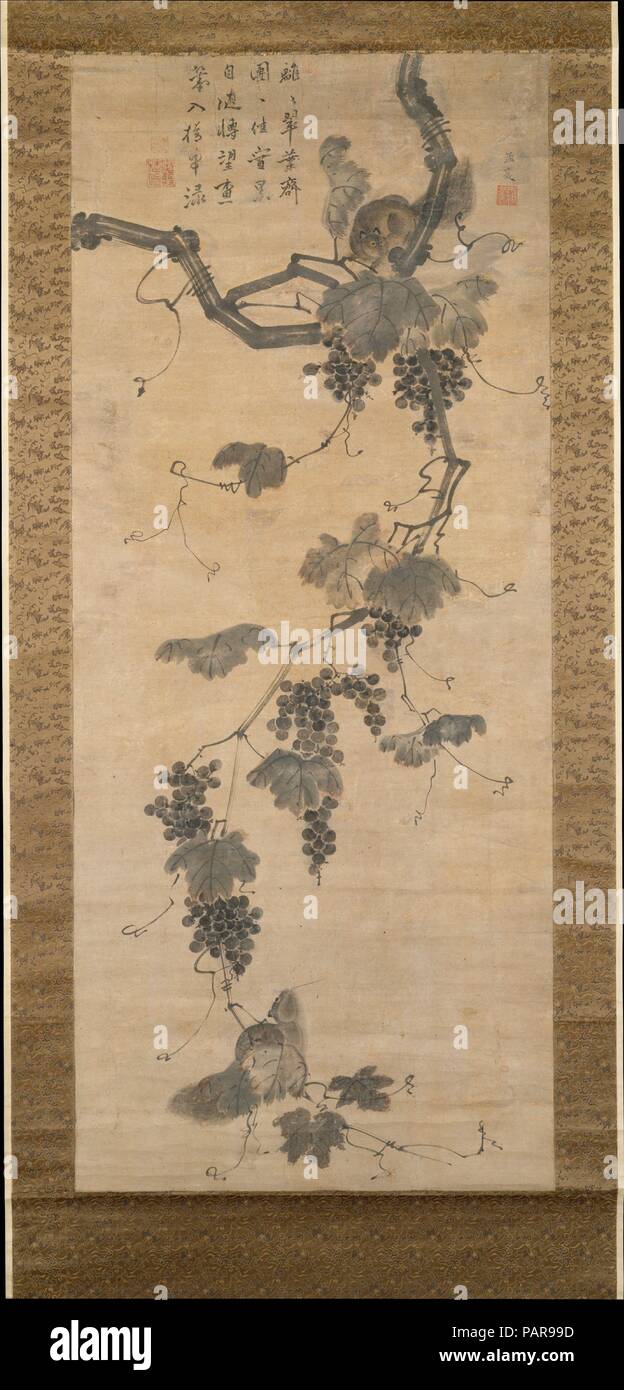 Grapevine and Squirrels. Artist: Unidentified Artist. Culture: Korea. Dimensions: Image: 54 x 22 3/4 in. (137.2 x 57.8 cm) Overall with mounting: 74 3/4 x 29 1/2 in. (189.9 x 74.9 cm) Overall with knobs: 74 3/4 x 31 3/4 in. (189.9 x 80.6 cm). Date: early 19th century. The subject of grapevine rendered in ink was popular among literati painters throughout the Choson period. Artists who won fame as painters of grapevine include Sim Saimdang (1504-1551), Huang Chip-chung (b.1533), and Hong Suju (1642-1704). While earlier paintings of the subject are mostly in the form of album leaves, ink-grap Stock Photohttps://www.alamy.com/image-license-details/?v=1https://www.alamy.com/grapevine-and-squirrels-artist-unidentified-artist-culture-korea-dimensions-image-54-x-22-34-in-1372-x-578-cm-overall-with-mounting-74-34-x-29-12-in-1899-x-749-cm-overall-with-knobs-74-34-x-31-34-in-1899-x-806-cm-date-early-19th-century-the-subject-of-grapevine-rendered-in-ink-was-popular-among-literati-painters-throughout-the-choson-period-artists-who-won-fame-as-painters-of-grapevine-include-sim-saimdang-1504-1551-huang-chip-chung-b1533-and-hong-suju-1642-1704-while-earlier-paintings-of-the-subject-are-mostly-in-the-form-of-album-leaves-ink-grap-image213183193.html
Grapevine and Squirrels. Artist: Unidentified Artist. Culture: Korea. Dimensions: Image: 54 x 22 3/4 in. (137.2 x 57.8 cm) Overall with mounting: 74 3/4 x 29 1/2 in. (189.9 x 74.9 cm) Overall with knobs: 74 3/4 x 31 3/4 in. (189.9 x 80.6 cm). Date: early 19th century. The subject of grapevine rendered in ink was popular among literati painters throughout the Choson period. Artists who won fame as painters of grapevine include Sim Saimdang (1504-1551), Huang Chip-chung (b.1533), and Hong Suju (1642-1704). While earlier paintings of the subject are mostly in the form of album leaves, ink-grap Stock Photohttps://www.alamy.com/image-license-details/?v=1https://www.alamy.com/grapevine-and-squirrels-artist-unidentified-artist-culture-korea-dimensions-image-54-x-22-34-in-1372-x-578-cm-overall-with-mounting-74-34-x-29-12-in-1899-x-749-cm-overall-with-knobs-74-34-x-31-34-in-1899-x-806-cm-date-early-19th-century-the-subject-of-grapevine-rendered-in-ink-was-popular-among-literati-painters-throughout-the-choson-period-artists-who-won-fame-as-painters-of-grapevine-include-sim-saimdang-1504-1551-huang-chip-chung-b1533-and-hong-suju-1642-1704-while-earlier-paintings-of-the-subject-are-mostly-in-the-form-of-album-leaves-ink-grap-image213183193.htmlRMPAR99D–Grapevine and Squirrels. Artist: Unidentified Artist. Culture: Korea. Dimensions: Image: 54 x 22 3/4 in. (137.2 x 57.8 cm) Overall with mounting: 74 3/4 x 29 1/2 in. (189.9 x 74.9 cm) Overall with knobs: 74 3/4 x 31 3/4 in. (189.9 x 80.6 cm). Date: early 19th century. The subject of grapevine rendered in ink was popular among literati painters throughout the Choson period. Artists who won fame as painters of grapevine include Sim Saimdang (1504-1551), Huang Chip-chung (b.1533), and Hong Suju (1642-1704). While earlier paintings of the subject are mostly in the form of album leaves, ink-grap
 Ball, Choson dynasty (1392–1910), 19th century, Korea, Korea, Silk, shaped in twelve pentagonal, six hexagonal, and two circular motifs of satin, satin damask, twill, and plain weaves, some self-patterned, all embroidered with silk in knot, ribbed back stitched wheel, single, darned and padded satin, running, and whipped running stitches, pile formed from cut running stitches, padded with paper, laid work and couching, pieced with cotton in overcast stitches, underlaid with cotton, plain weave, padded, and filled with rattling element, Approx. diam. 16.5 cm (6 1/2 in.), Reimagined by Gibon, de Stock Photohttps://www.alamy.com/image-license-details/?v=1https://www.alamy.com/ball-choson-dynasty-13921910-19th-century-korea-korea-silk-shaped-in-twelve-pentagonal-six-hexagonal-and-two-circular-motifs-of-satin-satin-damask-twill-and-plain-weaves-some-self-patterned-all-embroidered-with-silk-in-knot-ribbed-back-stitched-wheel-single-darned-and-padded-satin-running-and-whipped-running-stitches-pile-formed-from-cut-running-stitches-padded-with-paper-laid-work-and-couching-pieced-with-cotton-in-overcast-stitches-underlaid-with-cotton-plain-weave-padded-and-filled-with-rattling-element-approx-diam-165-cm-6-12-in-reimagined-by-gibon-de-image349745935.html
Ball, Choson dynasty (1392–1910), 19th century, Korea, Korea, Silk, shaped in twelve pentagonal, six hexagonal, and two circular motifs of satin, satin damask, twill, and plain weaves, some self-patterned, all embroidered with silk in knot, ribbed back stitched wheel, single, darned and padded satin, running, and whipped running stitches, pile formed from cut running stitches, padded with paper, laid work and couching, pieced with cotton in overcast stitches, underlaid with cotton, plain weave, padded, and filled with rattling element, Approx. diam. 16.5 cm (6 1/2 in.), Reimagined by Gibon, de Stock Photohttps://www.alamy.com/image-license-details/?v=1https://www.alamy.com/ball-choson-dynasty-13921910-19th-century-korea-korea-silk-shaped-in-twelve-pentagonal-six-hexagonal-and-two-circular-motifs-of-satin-satin-damask-twill-and-plain-weaves-some-self-patterned-all-embroidered-with-silk-in-knot-ribbed-back-stitched-wheel-single-darned-and-padded-satin-running-and-whipped-running-stitches-pile-formed-from-cut-running-stitches-padded-with-paper-laid-work-and-couching-pieced-with-cotton-in-overcast-stitches-underlaid-with-cotton-plain-weave-padded-and-filled-with-rattling-element-approx-diam-165-cm-6-12-in-reimagined-by-gibon-de-image349745935.htmlRF2B908E7–Ball, Choson dynasty (1392–1910), 19th century, Korea, Korea, Silk, shaped in twelve pentagonal, six hexagonal, and two circular motifs of satin, satin damask, twill, and plain weaves, some self-patterned, all embroidered with silk in knot, ribbed back stitched wheel, single, darned and padded satin, running, and whipped running stitches, pile formed from cut running stitches, padded with paper, laid work and couching, pieced with cotton in overcast stitches, underlaid with cotton, plain weave, padded, and filled with rattling element, Approx. diam. 16.5 cm (6 1/2 in.), Reimagined by Gibon, de
 Ball, Choson dynasty (1392–1910), 19th century, Korea, Korea, Silk, shaped in twelve pentagonal, six hexagonal, and two circular motifs of satin, satin damask, twill, and plain weaves, some self-patterned, all embroidered with silk in knot, ribbed back stitched wheel, single, darned and padded satin, running, and whipped running stitches, pile formed from cut running stitches, padded with paper, laid work and couching, pieced with cotton in overcast stitches, underlaid with cotton, plain weave, padded, and filled with rattling element, Approx. diam. 16.5 cm (6 1/2 in Stock Photohttps://www.alamy.com/image-license-details/?v=1https://www.alamy.com/ball-choson-dynasty-13921910-19th-century-korea-korea-silk-shaped-in-twelve-pentagonal-six-hexagonal-and-two-circular-motifs-of-satin-satin-damask-twill-and-plain-weaves-some-self-patterned-all-embroidered-with-silk-in-knot-ribbed-back-stitched-wheel-single-darned-and-padded-satin-running-and-whipped-running-stitches-pile-formed-from-cut-running-stitches-padded-with-paper-laid-work-and-couching-pieced-with-cotton-in-overcast-stitches-underlaid-with-cotton-plain-weave-padded-and-filled-with-rattling-element-approx-diam-165-cm-6-12-in-image328658909.html
Ball, Choson dynasty (1392–1910), 19th century, Korea, Korea, Silk, shaped in twelve pentagonal, six hexagonal, and two circular motifs of satin, satin damask, twill, and plain weaves, some self-patterned, all embroidered with silk in knot, ribbed back stitched wheel, single, darned and padded satin, running, and whipped running stitches, pile formed from cut running stitches, padded with paper, laid work and couching, pieced with cotton in overcast stitches, underlaid with cotton, plain weave, padded, and filled with rattling element, Approx. diam. 16.5 cm (6 1/2 in Stock Photohttps://www.alamy.com/image-license-details/?v=1https://www.alamy.com/ball-choson-dynasty-13921910-19th-century-korea-korea-silk-shaped-in-twelve-pentagonal-six-hexagonal-and-two-circular-motifs-of-satin-satin-damask-twill-and-plain-weaves-some-self-patterned-all-embroidered-with-silk-in-knot-ribbed-back-stitched-wheel-single-darned-and-padded-satin-running-and-whipped-running-stitches-pile-formed-from-cut-running-stitches-padded-with-paper-laid-work-and-couching-pieced-with-cotton-in-overcast-stitches-underlaid-with-cotton-plain-weave-padded-and-filled-with-rattling-element-approx-diam-165-cm-6-12-in-image328658909.htmlRM2A2KKP5–Ball, Choson dynasty (1392–1910), 19th century, Korea, Korea, Silk, shaped in twelve pentagonal, six hexagonal, and two circular motifs of satin, satin damask, twill, and plain weaves, some self-patterned, all embroidered with silk in knot, ribbed back stitched wheel, single, darned and padded satin, running, and whipped running stitches, pile formed from cut running stitches, padded with paper, laid work and couching, pieced with cotton in overcast stitches, underlaid with cotton, plain weave, padded, and filled with rattling element, Approx. diam. 16.5 cm (6 1/2 in
 Korea: Atlas of the World ('Ch'ŏnha chido') showing China, the 'Middle Kingdom', as the centre of the world, 19th century This Ch'ŏnha chido ('Map Of All Under Heaven') was produced in Korea in the 19th century, a copy of a traditional Korean atlas produced in the early Choson Dynasty (1392-1910). The structure of the map is simple. A main continent, containing China, Korea and a number of historically known countries occupies the centre of the circular map, surrounded by an enclosing sea ring, which is itself surrounded by an outer ring of land. Stock Photohttps://www.alamy.com/image-license-details/?v=1https://www.alamy.com/korea-atlas-of-the-world-chnha-chido-showing-china-the-middle-kingdom-as-the-centre-of-the-world-19th-century-this-chnha-chido-map-of-all-under-heaven-was-produced-in-korea-in-the-19th-century-a-copy-of-a-traditional-korean-atlas-produced-in-the-early-choson-dynasty-1392-1910-the-structure-of-the-map-is-simple-a-main-continent-containing-china-korea-and-a-number-of-historically-known-countries-occupies-the-centre-of-the-circular-map-surrounded-by-an-enclosing-sea-ring-which-is-itself-surrounded-by-an-outer-ring-of-land-image344251726.html
Korea: Atlas of the World ('Ch'ŏnha chido') showing China, the 'Middle Kingdom', as the centre of the world, 19th century This Ch'ŏnha chido ('Map Of All Under Heaven') was produced in Korea in the 19th century, a copy of a traditional Korean atlas produced in the early Choson Dynasty (1392-1910). The structure of the map is simple. A main continent, containing China, Korea and a number of historically known countries occupies the centre of the circular map, surrounded by an enclosing sea ring, which is itself surrounded by an outer ring of land. Stock Photohttps://www.alamy.com/image-license-details/?v=1https://www.alamy.com/korea-atlas-of-the-world-chnha-chido-showing-china-the-middle-kingdom-as-the-centre-of-the-world-19th-century-this-chnha-chido-map-of-all-under-heaven-was-produced-in-korea-in-the-19th-century-a-copy-of-a-traditional-korean-atlas-produced-in-the-early-choson-dynasty-1392-1910-the-structure-of-the-map-is-simple-a-main-continent-containing-china-korea-and-a-number-of-historically-known-countries-occupies-the-centre-of-the-circular-map-surrounded-by-an-enclosing-sea-ring-which-is-itself-surrounded-by-an-outer-ring-of-land-image344251726.htmlRM2B020GE–Korea: Atlas of the World ('Ch'ŏnha chido') showing China, the 'Middle Kingdom', as the centre of the world, 19th century This Ch'ŏnha chido ('Map Of All Under Heaven') was produced in Korea in the 19th century, a copy of a traditional Korean atlas produced in the early Choson Dynasty (1392-1910). The structure of the map is simple. A main continent, containing China, Korea and a number of historically known countries occupies the centre of the circular map, surrounded by an enclosing sea ring, which is itself surrounded by an outer ring of land.
 Wrapping Cloth (pojagi), Korea, Choson dynasty (1392-1910), 19th century. Stock Photohttps://www.alamy.com/image-license-details/?v=1https://www.alamy.com/wrapping-cloth-pojagi-korea-choson-dynasty-1392-1910-19th-century-image466983209.html
Wrapping Cloth (pojagi), Korea, Choson dynasty (1392-1910), 19th century. Stock Photohttps://www.alamy.com/image-license-details/?v=1https://www.alamy.com/wrapping-cloth-pojagi-korea-choson-dynasty-1392-1910-19th-century-image466983209.htmlRM2J3MWRN–Wrapping Cloth (pojagi), Korea, Choson dynasty (1392-1910), 19th century.
 774 Korean, Arhat and Deer, Late 17th century, Korea, Choson period, Yi dynasty (1392–1910), Ink, mineral pigments, and gold on silk, Kimbell Art Museum Stock Photohttps://www.alamy.com/image-license-details/?v=1https://www.alamy.com/774-korean-arhat-and-deer-late-17th-century-korea-choson-period-yi-dynasty-13921910-ink-mineral-pigments-and-gold-on-silk-kimbell-art-museum-image185821350.html
774 Korean, Arhat and Deer, Late 17th century, Korea, Choson period, Yi dynasty (1392–1910), Ink, mineral pigments, and gold on silk, Kimbell Art Museum Stock Photohttps://www.alamy.com/image-license-details/?v=1https://www.alamy.com/774-korean-arhat-and-deer-late-17th-century-korea-choson-period-yi-dynasty-13921910-ink-mineral-pigments-and-gold-on-silk-kimbell-art-museum-image185821350.htmlRMMP8W0P–774 Korean, Arhat and Deer, Late 17th century, Korea, Choson period, Yi dynasty (1392–1910), Ink, mineral pigments, and gold on silk, Kimbell Art Museum
 Wrapping Cloth (pojagi), Choson dynasty (1392–1910), 19th century, Korea, Korea, Silk, eighty-one pieced squares, outer edge, and backing, ribbons of plain gauze weave self-patterned by areas of plain weave, squares joined with silk in overcast stitches, edging joined with silk in back stitches, ribbon embellished with silk, plain weave tapes, 66.7 x 67 cm (26 3/8 x 26 3/8 in.), Reimagined by Gibon, design of warm cheerful glowing of brightness and light rays radiance. Classic art reinvented with a modern twist. Photography inspired by futurism, embracing dynamic energy of modern technology, m Stock Photohttps://www.alamy.com/image-license-details/?v=1https://www.alamy.com/wrapping-cloth-pojagi-choson-dynasty-13921910-19th-century-korea-korea-silk-eighty-one-pieced-squares-outer-edge-and-backing-ribbons-of-plain-gauze-weave-self-patterned-by-areas-of-plain-weave-squares-joined-with-silk-in-overcast-stitches-edging-joined-with-silk-in-back-stitches-ribbon-embellished-with-silk-plain-weave-tapes-667-x-67-cm-26-38-x-26-38-in-reimagined-by-gibon-design-of-warm-cheerful-glowing-of-brightness-and-light-rays-radiance-classic-art-reinvented-with-a-modern-twist-photography-inspired-by-futurism-embracing-dynamic-energy-of-modern-technology-m-image349745934.html
Wrapping Cloth (pojagi), Choson dynasty (1392–1910), 19th century, Korea, Korea, Silk, eighty-one pieced squares, outer edge, and backing, ribbons of plain gauze weave self-patterned by areas of plain weave, squares joined with silk in overcast stitches, edging joined with silk in back stitches, ribbon embellished with silk, plain weave tapes, 66.7 x 67 cm (26 3/8 x 26 3/8 in.), Reimagined by Gibon, design of warm cheerful glowing of brightness and light rays radiance. Classic art reinvented with a modern twist. Photography inspired by futurism, embracing dynamic energy of modern technology, m Stock Photohttps://www.alamy.com/image-license-details/?v=1https://www.alamy.com/wrapping-cloth-pojagi-choson-dynasty-13921910-19th-century-korea-korea-silk-eighty-one-pieced-squares-outer-edge-and-backing-ribbons-of-plain-gauze-weave-self-patterned-by-areas-of-plain-weave-squares-joined-with-silk-in-overcast-stitches-edging-joined-with-silk-in-back-stitches-ribbon-embellished-with-silk-plain-weave-tapes-667-x-67-cm-26-38-x-26-38-in-reimagined-by-gibon-design-of-warm-cheerful-glowing-of-brightness-and-light-rays-radiance-classic-art-reinvented-with-a-modern-twist-photography-inspired-by-futurism-embracing-dynamic-energy-of-modern-technology-m-image349745934.htmlRF2B908E6–Wrapping Cloth (pojagi), Choson dynasty (1392–1910), 19th century, Korea, Korea, Silk, eighty-one pieced squares, outer edge, and backing, ribbons of plain gauze weave self-patterned by areas of plain weave, squares joined with silk in overcast stitches, edging joined with silk in back stitches, ribbon embellished with silk, plain weave tapes, 66.7 x 67 cm (26 3/8 x 26 3/8 in.), Reimagined by Gibon, design of warm cheerful glowing of brightness and light rays radiance. Classic art reinvented with a modern twist. Photography inspired by futurism, embracing dynamic energy of modern technology, m
 Lidded box, box with lid., anonymous, Korea, c. 1200 - c. 1500, Koryo dynasty (918-1392) / Choson-dynasty (1392-1910), bronze (metal), h 9.5 cm × d 19 cm Stock Photohttps://www.alamy.com/image-license-details/?v=1https://www.alamy.com/lidded-box-box-with-lid-anonymous-korea-c-1200-c-1500-koryo-dynasty-918-1392-choson-dynasty-1392-1910-bronze-metal-h-95-cm-d-19-cm-image261318211.html
Lidded box, box with lid., anonymous, Korea, c. 1200 - c. 1500, Koryo dynasty (918-1392) / Choson-dynasty (1392-1910), bronze (metal), h 9.5 cm × d 19 cm Stock Photohttps://www.alamy.com/image-license-details/?v=1https://www.alamy.com/lidded-box-box-with-lid-anonymous-korea-c-1200-c-1500-koryo-dynasty-918-1392-choson-dynasty-1392-1910-bronze-metal-h-95-cm-d-19-cm-image261318211.htmlRMW54217–Lidded box, box with lid., anonymous, Korea, c. 1200 - c. 1500, Koryo dynasty (918-1392) / Choson-dynasty (1392-1910), bronze (metal), h 9.5 cm × d 19 cm
 Korea: Atlas of the World ('Ch'ŏnha chido') showing China, the 'Middle Kingdom', as the centre of the world, 17th century This Ch'ŏnha chido ('Map Of All Under Heaven') was produced in Korea in the 17th century, a copy of a traditional Korean atlas produced in the early Choson Dynasty (1392-1910). The structure of the map is simple. A main continent, containing China, Korea and a number of historically known countries occupies the centre of the circular map, surrounded by an enclosing sea ring, which is itself surrounded by an outer ring of land. Stock Photohttps://www.alamy.com/image-license-details/?v=1https://www.alamy.com/korea-atlas-of-the-world-chnha-chido-showing-china-the-middle-kingdom-as-the-centre-of-the-world-17th-century-this-chnha-chido-map-of-all-under-heaven-was-produced-in-korea-in-the-17th-century-a-copy-of-a-traditional-korean-atlas-produced-in-the-early-choson-dynasty-1392-1910-the-structure-of-the-map-is-simple-a-main-continent-containing-china-korea-and-a-number-of-historically-known-countries-occupies-the-centre-of-the-circular-map-surrounded-by-an-enclosing-sea-ring-which-is-itself-surrounded-by-an-outer-ring-of-land-image344251727.html
Korea: Atlas of the World ('Ch'ŏnha chido') showing China, the 'Middle Kingdom', as the centre of the world, 17th century This Ch'ŏnha chido ('Map Of All Under Heaven') was produced in Korea in the 17th century, a copy of a traditional Korean atlas produced in the early Choson Dynasty (1392-1910). The structure of the map is simple. A main continent, containing China, Korea and a number of historically known countries occupies the centre of the circular map, surrounded by an enclosing sea ring, which is itself surrounded by an outer ring of land. Stock Photohttps://www.alamy.com/image-license-details/?v=1https://www.alamy.com/korea-atlas-of-the-world-chnha-chido-showing-china-the-middle-kingdom-as-the-centre-of-the-world-17th-century-this-chnha-chido-map-of-all-under-heaven-was-produced-in-korea-in-the-17th-century-a-copy-of-a-traditional-korean-atlas-produced-in-the-early-choson-dynasty-1392-1910-the-structure-of-the-map-is-simple-a-main-continent-containing-china-korea-and-a-number-of-historically-known-countries-occupies-the-centre-of-the-circular-map-surrounded-by-an-enclosing-sea-ring-which-is-itself-surrounded-by-an-outer-ring-of-land-image344251727.htmlRM2B020GF–Korea: Atlas of the World ('Ch'ŏnha chido') showing China, the 'Middle Kingdom', as the centre of the world, 17th century This Ch'ŏnha chido ('Map Of All Under Heaven') was produced in Korea in the 17th century, a copy of a traditional Korean atlas produced in the early Choson Dynasty (1392-1910). The structure of the map is simple. A main continent, containing China, Korea and a number of historically known countries occupies the centre of the circular map, surrounded by an enclosing sea ring, which is itself surrounded by an outer ring of land.
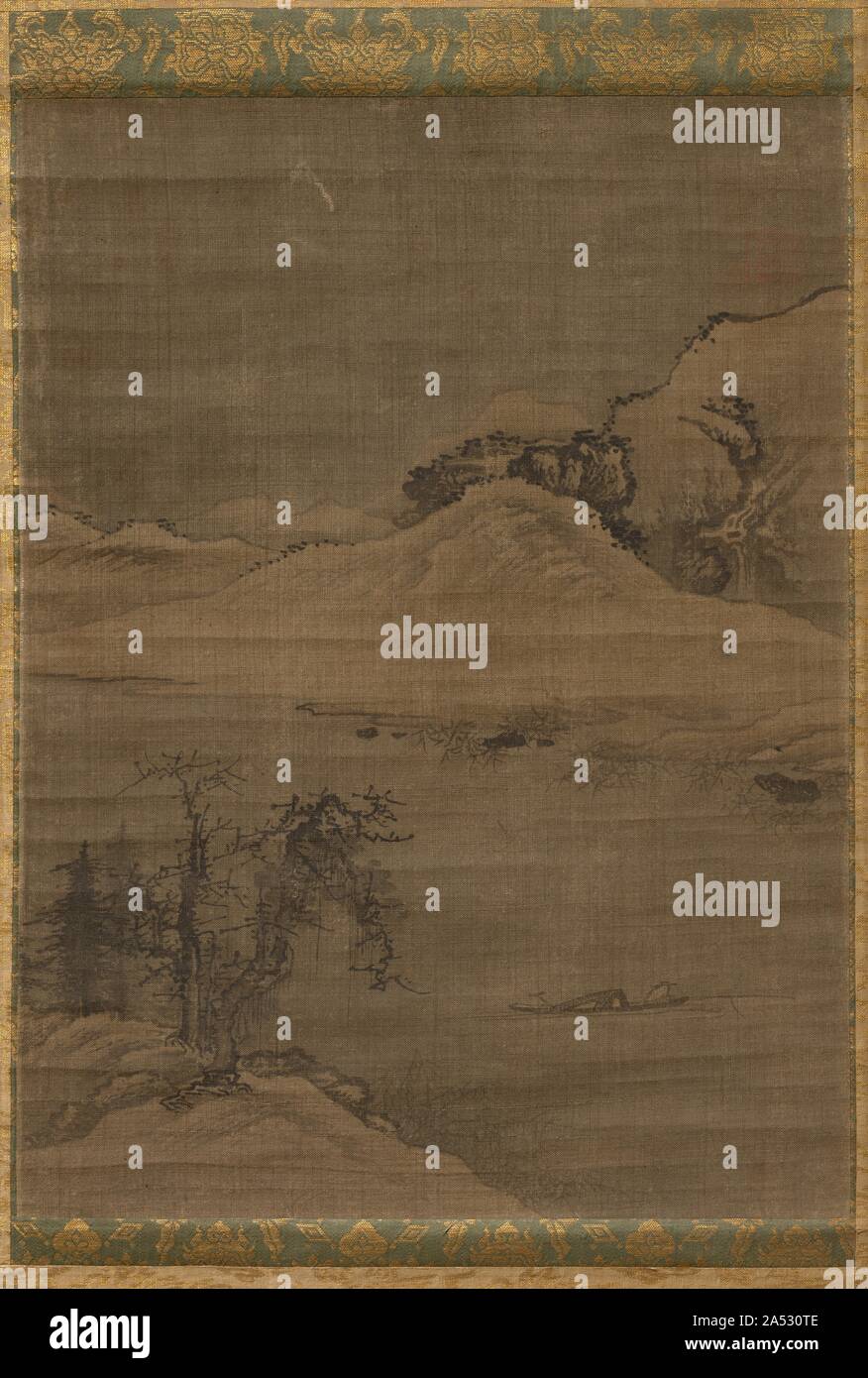 Landscape with Fishermen, 1600s. Surviving paintings of the early Choson period in Korea, while not numerous, provide modern viewers with a consistent ensemble of subject matter, painting formats, and stylistic approaches. Along with landscape painting, animal, bird, and flower paintings, a few portraits, grapes, bamboo, figural compositions, and kyehoe-do (commem-orative rites scenes) make up the basic repertoire of subjects. The late 15th- and 16th-century landscapes that have survived, however, are modest in format. Korean painters preferred to work in a restricted compositional arena. The Stock Photohttps://www.alamy.com/image-license-details/?v=1https://www.alamy.com/landscape-with-fishermen-1600s-surviving-paintings-of-the-early-choson-period-in-korea-while-not-numerous-provide-modern-viewers-with-a-consistent-ensemble-of-subject-matter-painting-formats-and-stylistic-approaches-along-with-landscape-painting-animal-bird-and-flower-paintings-a-few-portraits-grapes-bamboo-figural-compositions-and-kyehoe-do-commem-orative-rites-scenes-make-up-the-basic-repertoire-of-subjects-the-late-15th-and-16th-century-landscapes-that-have-survived-however-are-modest-in-format-korean-painters-preferred-to-work-in-a-restricted-compositional-arena-the-image330136814.html
Landscape with Fishermen, 1600s. Surviving paintings of the early Choson period in Korea, while not numerous, provide modern viewers with a consistent ensemble of subject matter, painting formats, and stylistic approaches. Along with landscape painting, animal, bird, and flower paintings, a few portraits, grapes, bamboo, figural compositions, and kyehoe-do (commem-orative rites scenes) make up the basic repertoire of subjects. The late 15th- and 16th-century landscapes that have survived, however, are modest in format. Korean painters preferred to work in a restricted compositional arena. The Stock Photohttps://www.alamy.com/image-license-details/?v=1https://www.alamy.com/landscape-with-fishermen-1600s-surviving-paintings-of-the-early-choson-period-in-korea-while-not-numerous-provide-modern-viewers-with-a-consistent-ensemble-of-subject-matter-painting-formats-and-stylistic-approaches-along-with-landscape-painting-animal-bird-and-flower-paintings-a-few-portraits-grapes-bamboo-figural-compositions-and-kyehoe-do-commem-orative-rites-scenes-make-up-the-basic-repertoire-of-subjects-the-late-15th-and-16th-century-landscapes-that-have-survived-however-are-modest-in-format-korean-painters-preferred-to-work-in-a-restricted-compositional-arena-the-image330136814.htmlRM2A530TE–Landscape with Fishermen, 1600s. Surviving paintings of the early Choson period in Korea, while not numerous, provide modern viewers with a consistent ensemble of subject matter, painting formats, and stylistic approaches. Along with landscape painting, animal, bird, and flower paintings, a few portraits, grapes, bamboo, figural compositions, and kyehoe-do (commem-orative rites scenes) make up the basic repertoire of subjects. The late 15th- and 16th-century landscapes that have survived, however, are modest in format. Korean painters preferred to work in a restricted compositional arena. The
 Lidded box, box with lid., anonymous, Korea, c. 1200 - c. 1500, Koryo dynasty (918-1392) / Choson-dynasty (1392-1910), bronze (metal), h 9.5 cm × d 19 cm, Reimagined by Gibon, design of warm cheerful glowing of brightness and light rays radiance. Classic art reinvented with a modern twist. Photography inspired by futurism, embracing dynamic energy of modern technology, movement, speed and revolutionize culture. Stock Photohttps://www.alamy.com/image-license-details/?v=1https://www.alamy.com/lidded-box-box-with-lid-anonymous-korea-c-1200-c-1500-koryo-dynasty-918-1392-choson-dynasty-1392-1910-bronze-metal-h-95-cm-d-19-cm-reimagined-by-gibon-design-of-warm-cheerful-glowing-of-brightness-and-light-rays-radiance-classic-art-reinvented-with-a-modern-twist-photography-inspired-by-futurism-embracing-dynamic-energy-of-modern-technology-movement-speed-and-revolutionize-culture-image349939001.html
Lidded box, box with lid., anonymous, Korea, c. 1200 - c. 1500, Koryo dynasty (918-1392) / Choson-dynasty (1392-1910), bronze (metal), h 9.5 cm × d 19 cm, Reimagined by Gibon, design of warm cheerful glowing of brightness and light rays radiance. Classic art reinvented with a modern twist. Photography inspired by futurism, embracing dynamic energy of modern technology, movement, speed and revolutionize culture. Stock Photohttps://www.alamy.com/image-license-details/?v=1https://www.alamy.com/lidded-box-box-with-lid-anonymous-korea-c-1200-c-1500-koryo-dynasty-918-1392-choson-dynasty-1392-1910-bronze-metal-h-95-cm-d-19-cm-reimagined-by-gibon-design-of-warm-cheerful-glowing-of-brightness-and-light-rays-radiance-classic-art-reinvented-with-a-modern-twist-photography-inspired-by-futurism-embracing-dynamic-energy-of-modern-technology-movement-speed-and-revolutionize-culture-image349939001.htmlRF2B992ND–Lidded box, box with lid., anonymous, Korea, c. 1200 - c. 1500, Koryo dynasty (918-1392) / Choson-dynasty (1392-1910), bronze (metal), h 9.5 cm × d 19 cm, Reimagined by Gibon, design of warm cheerful glowing of brightness and light rays radiance. Classic art reinvented with a modern twist. Photography inspired by futurism, embracing dynamic energy of modern technology, movement, speed and revolutionize culture.
 Box, Lacquer box with lid, inlaid with mother-of-pearl floral motifs., anonymous, Korea, c. 1500 - c. 1700, Choson-dynasty (1392-1910), wood (plant material), lacquer (coating), mother of pearl, h 18.0 cm × w 27.0 cm × d 4.3 cm Stock Photohttps://www.alamy.com/image-license-details/?v=1https://www.alamy.com/box-lacquer-box-with-lid-inlaid-with-mother-of-pearl-floral-motifs-anonymous-korea-c-1500-c-1700-choson-dynasty-1392-1910-wood-plant-material-lacquer-coating-mother-of-pearl-h-180-cm-w-270-cm-d-43-cm-image261318046.html
Box, Lacquer box with lid, inlaid with mother-of-pearl floral motifs., anonymous, Korea, c. 1500 - c. 1700, Choson-dynasty (1392-1910), wood (plant material), lacquer (coating), mother of pearl, h 18.0 cm × w 27.0 cm × d 4.3 cm Stock Photohttps://www.alamy.com/image-license-details/?v=1https://www.alamy.com/box-lacquer-box-with-lid-inlaid-with-mother-of-pearl-floral-motifs-anonymous-korea-c-1500-c-1700-choson-dynasty-1392-1910-wood-plant-material-lacquer-coating-mother-of-pearl-h-180-cm-w-270-cm-d-43-cm-image261318046.htmlRMW541RA–Box, Lacquer box with lid, inlaid with mother-of-pearl floral motifs., anonymous, Korea, c. 1500 - c. 1700, Choson-dynasty (1392-1910), wood (plant material), lacquer (coating), mother of pearl, h 18.0 cm × w 27.0 cm × d 4.3 cm
 Flask with Fish, Korea, Joseon dynasty (1392-1910), 15th century. Stock Photohttps://www.alamy.com/image-license-details/?v=1https://www.alamy.com/flask-with-fish-korea-joseon-dynasty-1392-1910-15th-century-image453136718.html
Flask with Fish, Korea, Joseon dynasty (1392-1910), 15th century. Stock Photohttps://www.alamy.com/image-license-details/?v=1https://www.alamy.com/flask-with-fish-korea-joseon-dynasty-1392-1910-15th-century-image453136718.htmlRM2H964E6–Flask with Fish, Korea, Joseon dynasty (1392-1910), 15th century.
 Box, Lacquer box with lid, inlaid with mother-of-pearl floral motifs., anonymous, Korea, c. 1500 - c. 1700, Choson-dynasty (1392-1910), wood (plant material), lacquer (coating), mother of pearl, h 18.0 cm × w 27.0 cm × d 4.3 cm, Reimagined by Gibon, design of warm cheerful glowing of brightness and light rays radiance. Classic art reinvented with a modern twist. Photography inspired by futurism, embracing dynamic energy of modern technology, movement, speed and revolutionize culture. Stock Photohttps://www.alamy.com/image-license-details/?v=1https://www.alamy.com/box-lacquer-box-with-lid-inlaid-with-mother-of-pearl-floral-motifs-anonymous-korea-c-1500-c-1700-choson-dynasty-1392-1910-wood-plant-material-lacquer-coating-mother-of-pearl-h-180-cm-w-270-cm-d-43-cm-reimagined-by-gibon-design-of-warm-cheerful-glowing-of-brightness-and-light-rays-radiance-classic-art-reinvented-with-a-modern-twist-photography-inspired-by-futurism-embracing-dynamic-energy-of-modern-technology-movement-speed-and-revolutionize-culture-image349938879.html
Box, Lacquer box with lid, inlaid with mother-of-pearl floral motifs., anonymous, Korea, c. 1500 - c. 1700, Choson-dynasty (1392-1910), wood (plant material), lacquer (coating), mother of pearl, h 18.0 cm × w 27.0 cm × d 4.3 cm, Reimagined by Gibon, design of warm cheerful glowing of brightness and light rays radiance. Classic art reinvented with a modern twist. Photography inspired by futurism, embracing dynamic energy of modern technology, movement, speed and revolutionize culture. Stock Photohttps://www.alamy.com/image-license-details/?v=1https://www.alamy.com/box-lacquer-box-with-lid-inlaid-with-mother-of-pearl-floral-motifs-anonymous-korea-c-1500-c-1700-choson-dynasty-1392-1910-wood-plant-material-lacquer-coating-mother-of-pearl-h-180-cm-w-270-cm-d-43-cm-reimagined-by-gibon-design-of-warm-cheerful-glowing-of-brightness-and-light-rays-radiance-classic-art-reinvented-with-a-modern-twist-photography-inspired-by-futurism-embracing-dynamic-energy-of-modern-technology-movement-speed-and-revolutionize-culture-image349938879.htmlRF2B992H3–Box, Lacquer box with lid, inlaid with mother-of-pearl floral motifs., anonymous, Korea, c. 1500 - c. 1700, Choson-dynasty (1392-1910), wood (plant material), lacquer (coating), mother of pearl, h 18.0 cm × w 27.0 cm × d 4.3 cm, Reimagined by Gibon, design of warm cheerful glowing of brightness and light rays radiance. Classic art reinvented with a modern twist. Photography inspired by futurism, embracing dynamic energy of modern technology, movement, speed and revolutionize culture.
 Writing tool box, Writing tool box made of wood with black varnish base, inlaid with mother-of-pearl and braided brass wire. The chest is equipped with an extendable drawer on the right. The decoration consists of lotus vines., anonymous, Korea, 1400 - 1500, Choson-dynasty (1392-1910), wood (plant material), lacquer (coating), mother of pearl, brass (alloy), w 44.4 cm × h 22.8 cm × d 26.5 cm Stock Photohttps://www.alamy.com/image-license-details/?v=1https://www.alamy.com/writing-tool-box-writing-tool-box-made-of-wood-with-black-varnish-base-inlaid-with-mother-of-pearl-and-braided-brass-wire-the-chest-is-equipped-with-an-extendable-drawer-on-the-right-the-decoration-consists-of-lotus-vines-anonymous-korea-1400-1500-choson-dynasty-1392-1910-wood-plant-material-lacquer-coating-mother-of-pearl-brass-alloy-w-444-cm-h-228-cm-d-265-cm-image261317700.html
Writing tool box, Writing tool box made of wood with black varnish base, inlaid with mother-of-pearl and braided brass wire. The chest is equipped with an extendable drawer on the right. The decoration consists of lotus vines., anonymous, Korea, 1400 - 1500, Choson-dynasty (1392-1910), wood (plant material), lacquer (coating), mother of pearl, brass (alloy), w 44.4 cm × h 22.8 cm × d 26.5 cm Stock Photohttps://www.alamy.com/image-license-details/?v=1https://www.alamy.com/writing-tool-box-writing-tool-box-made-of-wood-with-black-varnish-base-inlaid-with-mother-of-pearl-and-braided-brass-wire-the-chest-is-equipped-with-an-extendable-drawer-on-the-right-the-decoration-consists-of-lotus-vines-anonymous-korea-1400-1500-choson-dynasty-1392-1910-wood-plant-material-lacquer-coating-mother-of-pearl-brass-alloy-w-444-cm-h-228-cm-d-265-cm-image261317700.htmlRMW541B0–Writing tool box, Writing tool box made of wood with black varnish base, inlaid with mother-of-pearl and braided brass wire. The chest is equipped with an extendable drawer on the right. The decoration consists of lotus vines., anonymous, Korea, 1400 - 1500, Choson-dynasty (1392-1910), wood (plant material), lacquer (coating), mother of pearl, brass (alloy), w 44.4 cm × h 22.8 cm × d 26.5 cm
 Jar, Korea, Joseon dynasty (1392-1910), early 18th century. Stock Photohttps://www.alamy.com/image-license-details/?v=1https://www.alamy.com/jar-korea-joseon-dynasty-1392-1910-early-18th-century-image453136864.html
Jar, Korea, Joseon dynasty (1392-1910), early 18th century. Stock Photohttps://www.alamy.com/image-license-details/?v=1https://www.alamy.com/jar-korea-joseon-dynasty-1392-1910-early-18th-century-image453136864.htmlRM2H964KC–Jar, Korea, Joseon dynasty (1392-1910), early 18th century.
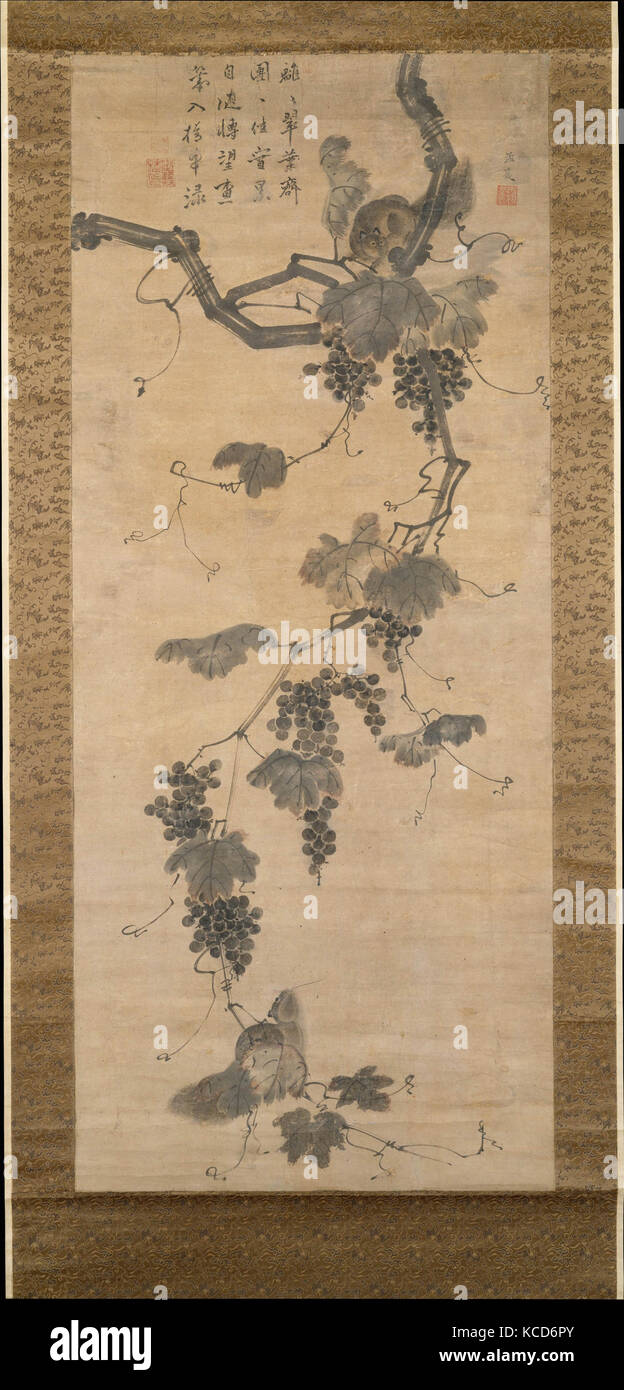 Grapevine and Squirrels, Unidentified Artist, early 19th century Stock Photohttps://www.alamy.com/image-license-details/?v=1https://www.alamy.com/stock-image-grapevine-and-squirrels-unidentified-artist-early-19th-century-162559907.html
Grapevine and Squirrels, Unidentified Artist, early 19th century Stock Photohttps://www.alamy.com/image-license-details/?v=1https://www.alamy.com/stock-image-grapevine-and-squirrels-unidentified-artist-early-19th-century-162559907.htmlRMKCD6PY–Grapevine and Squirrels, Unidentified Artist, early 19th century
 Writing tool box, Writing tool box made of wood with black varnish base, inlaid with mother-of-pearl and braided brass wire. The chest is equipped with an extendable drawer on the right. The decoration consists of lotus vines., anonymous, Korea, 1400 - 1500, Choson-dynasty (1392-1910), wood (plant material), lacquer (coating), mother of pearl, brass (alloy), w 44.4 cm × h 22.8 cm × d 26.5 cm, Reimagined by Gibon, design of warm cheerful glowing of brightness and light rays radiance. Classic art reinvented with a modern twist. Photography inspired by futurism, embracing dynamic energy of modern Stock Photohttps://www.alamy.com/image-license-details/?v=1https://www.alamy.com/writing-tool-box-writing-tool-box-made-of-wood-with-black-varnish-base-inlaid-with-mother-of-pearl-and-braided-brass-wire-the-chest-is-equipped-with-an-extendable-drawer-on-the-right-the-decoration-consists-of-lotus-vines-anonymous-korea-1400-1500-choson-dynasty-1392-1910-wood-plant-material-lacquer-coating-mother-of-pearl-brass-alloy-w-444-cm-h-228-cm-d-265-cm-reimagined-by-gibon-design-of-warm-cheerful-glowing-of-brightness-and-light-rays-radiance-classic-art-reinvented-with-a-modern-twist-photography-inspired-by-futurism-embracing-dynamic-energy-of-modern-image349938517.html
Writing tool box, Writing tool box made of wood with black varnish base, inlaid with mother-of-pearl and braided brass wire. The chest is equipped with an extendable drawer on the right. The decoration consists of lotus vines., anonymous, Korea, 1400 - 1500, Choson-dynasty (1392-1910), wood (plant material), lacquer (coating), mother of pearl, brass (alloy), w 44.4 cm × h 22.8 cm × d 26.5 cm, Reimagined by Gibon, design of warm cheerful glowing of brightness and light rays radiance. Classic art reinvented with a modern twist. Photography inspired by futurism, embracing dynamic energy of modern Stock Photohttps://www.alamy.com/image-license-details/?v=1https://www.alamy.com/writing-tool-box-writing-tool-box-made-of-wood-with-black-varnish-base-inlaid-with-mother-of-pearl-and-braided-brass-wire-the-chest-is-equipped-with-an-extendable-drawer-on-the-right-the-decoration-consists-of-lotus-vines-anonymous-korea-1400-1500-choson-dynasty-1392-1910-wood-plant-material-lacquer-coating-mother-of-pearl-brass-alloy-w-444-cm-h-228-cm-d-265-cm-reimagined-by-gibon-design-of-warm-cheerful-glowing-of-brightness-and-light-rays-radiance-classic-art-reinvented-with-a-modern-twist-photography-inspired-by-futurism-embracing-dynamic-energy-of-modern-image349938517.htmlRF2B99245–Writing tool box, Writing tool box made of wood with black varnish base, inlaid with mother-of-pearl and braided brass wire. The chest is equipped with an extendable drawer on the right. The decoration consists of lotus vines., anonymous, Korea, 1400 - 1500, Choson-dynasty (1392-1910), wood (plant material), lacquer (coating), mother of pearl, brass (alloy), w 44.4 cm × h 22.8 cm × d 26.5 cm, Reimagined by Gibon, design of warm cheerful glowing of brightness and light rays radiance. Classic art reinvented with a modern twist. Photography inspired by futurism, embracing dynamic energy of modern
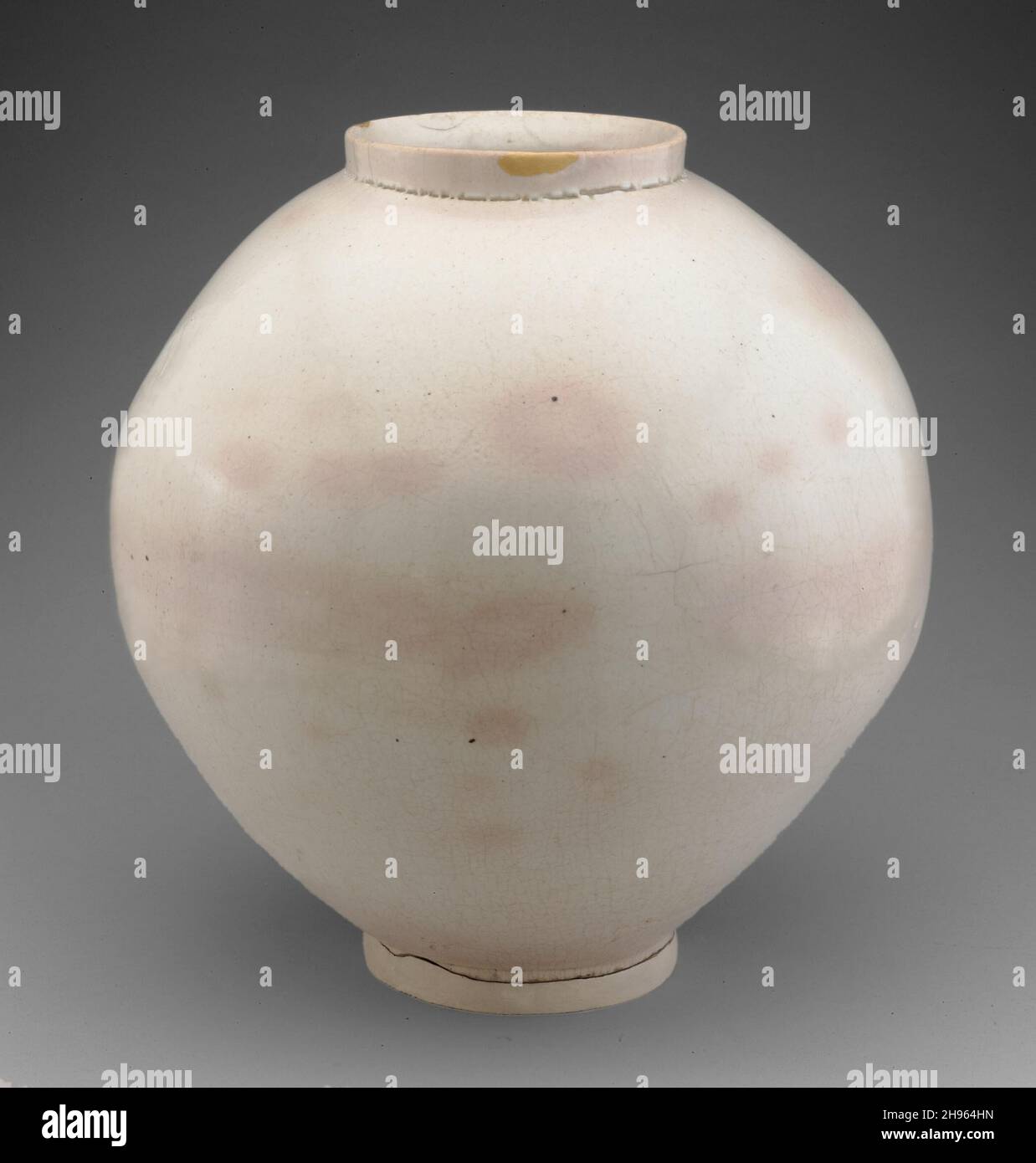 Moon Jar, Korea, Joseon dynasty (1392-1910), 17th century. Stock Photohttps://www.alamy.com/image-license-details/?v=1https://www.alamy.com/moon-jar-korea-joseon-dynasty-1392-1910-17th-century-image453136817.html
Moon Jar, Korea, Joseon dynasty (1392-1910), 17th century. Stock Photohttps://www.alamy.com/image-license-details/?v=1https://www.alamy.com/moon-jar-korea-joseon-dynasty-1392-1910-17th-century-image453136817.htmlRM2H964HN–Moon Jar, Korea, Joseon dynasty (1392-1910), 17th century.
 Jar with Abstract Strokes, Korea, Joseon dynasty (1392-1910), 17th century. Stock Photohttps://www.alamy.com/image-license-details/?v=1https://www.alamy.com/jar-with-abstract-strokes-korea-joseon-dynasty-1392-1910-17th-century-image453136827.html
Jar with Abstract Strokes, Korea, Joseon dynasty (1392-1910), 17th century. Stock Photohttps://www.alamy.com/image-license-details/?v=1https://www.alamy.com/jar-with-abstract-strokes-korea-joseon-dynasty-1392-1910-17th-century-image453136827.htmlRM2H964J3–Jar with Abstract Strokes, Korea, Joseon dynasty (1392-1910), 17th century.
 Faceted and Covered Jar, Korea, Joseon dynasty (1392-1910), 19th century. Stock Photohttps://www.alamy.com/image-license-details/?v=1https://www.alamy.com/faceted-and-covered-jar-korea-joseon-dynasty-1392-1910-19th-century-image453136851.html
Faceted and Covered Jar, Korea, Joseon dynasty (1392-1910), 19th century. Stock Photohttps://www.alamy.com/image-license-details/?v=1https://www.alamy.com/faceted-and-covered-jar-korea-joseon-dynasty-1392-1910-19th-century-image453136851.htmlRM2H964JY–Faceted and Covered Jar, Korea, Joseon dynasty (1392-1910), 19th century.
 Wine Bottle, Korea, Joseon Dynasty (1392-1910), 18th century. Stock Photohttps://www.alamy.com/image-license-details/?v=1https://www.alamy.com/wine-bottle-korea-joseon-dynasty-1392-1910-18th-century-image453136808.html
Wine Bottle, Korea, Joseon Dynasty (1392-1910), 18th century. Stock Photohttps://www.alamy.com/image-license-details/?v=1https://www.alamy.com/wine-bottle-korea-joseon-dynasty-1392-1910-18th-century-image453136808.htmlRM2H964HC–Wine Bottle, Korea, Joseon Dynasty (1392-1910), 18th century.
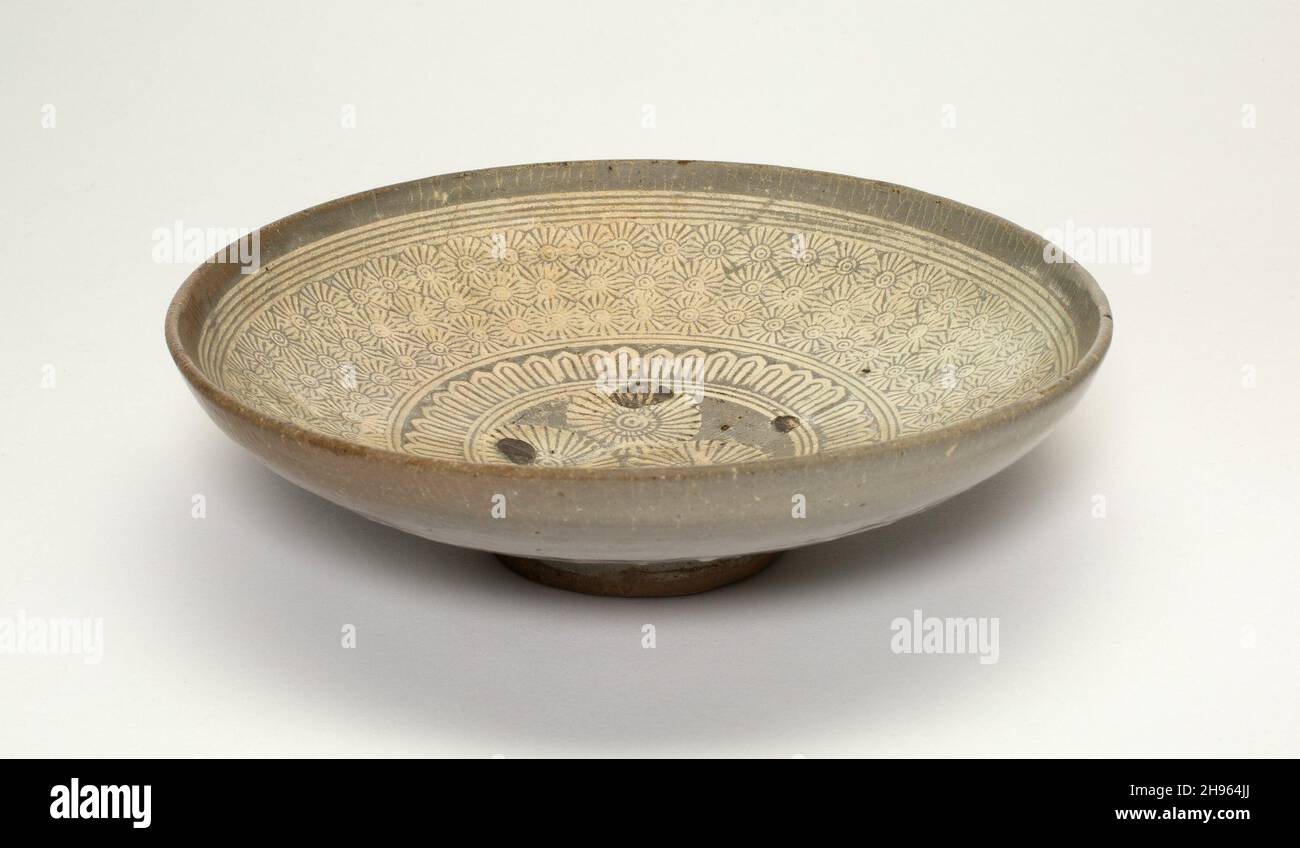 Bowl with Chrysanthemum Flower Heads, Korea, Joeson dynasty (1392-1910), 15th century. Stock Photohttps://www.alamy.com/image-license-details/?v=1https://www.alamy.com/bowl-with-chrysanthemum-flower-heads-korea-joeson-dynasty-1392-1910-15th-century-image453136842.html
Bowl with Chrysanthemum Flower Heads, Korea, Joeson dynasty (1392-1910), 15th century. Stock Photohttps://www.alamy.com/image-license-details/?v=1https://www.alamy.com/bowl-with-chrysanthemum-flower-heads-korea-joeson-dynasty-1392-1910-15th-century-image453136842.htmlRM2H964JJ–Bowl with Chrysanthemum Flower Heads, Korea, Joeson dynasty (1392-1910), 15th century.
 Jar with Dragon Chasing Flaming Pearl, Korea, Joseon dynasty(1392-1910), 17th century. Stock Photohttps://www.alamy.com/image-license-details/?v=1https://www.alamy.com/jar-with-dragon-chasing-flaming-pearl-korea-joseon-dynasty1392-1910-17th-century-image453136799.html
Jar with Dragon Chasing Flaming Pearl, Korea, Joseon dynasty(1392-1910), 17th century. Stock Photohttps://www.alamy.com/image-license-details/?v=1https://www.alamy.com/jar-with-dragon-chasing-flaming-pearl-korea-joseon-dynasty1392-1910-17th-century-image453136799.htmlRM2H964H3–Jar with Dragon Chasing Flaming Pearl, Korea, Joseon dynasty(1392-1910), 17th century.
 Vase with Cherry Blossom Branch and Bamboos, Korea, Joseon dynasty (1392-1910), 19th century. Stock Photohttps://www.alamy.com/image-license-details/?v=1https://www.alamy.com/vase-with-cherry-blossom-branch-and-bamboos-korea-joseon-dynasty-1392-1910-19th-century-image453136805.html
Vase with Cherry Blossom Branch and Bamboos, Korea, Joseon dynasty (1392-1910), 19th century. Stock Photohttps://www.alamy.com/image-license-details/?v=1https://www.alamy.com/vase-with-cherry-blossom-branch-and-bamboos-korea-joseon-dynasty-1392-1910-19th-century-image453136805.htmlRM2H964H9–Vase with Cherry Blossom Branch and Bamboos, Korea, Joseon dynasty (1392-1910), 19th century.
 Buddhist Pagoda, Korea, late Goryeo dynasty(918-1392)-early Joseon dynasty(1392-1910), 14th/16th century. Stock Photohttps://www.alamy.com/image-license-details/?v=1https://www.alamy.com/buddhist-pagoda-korea-late-goryeo-dynasty918-1392-early-joseon-dynasty1392-1910-14th16th-century-image453136853.html
Buddhist Pagoda, Korea, late Goryeo dynasty(918-1392)-early Joseon dynasty(1392-1910), 14th/16th century. Stock Photohttps://www.alamy.com/image-license-details/?v=1https://www.alamy.com/buddhist-pagoda-korea-late-goryeo-dynasty918-1392-early-joseon-dynasty1392-1910-14th16th-century-image453136853.htmlRM2H964K1–Buddhist Pagoda, Korea, late Goryeo dynasty(918-1392)-early Joseon dynasty(1392-1910), 14th/16th century.
 Bottle-Shaped Vase with Dragon Chasing Flaming Pearl, Korea, Joseon dynasty (1392-1910), 18th/19th century. Stock Photohttps://www.alamy.com/image-license-details/?v=1https://www.alamy.com/bottle-shaped-vase-with-dragon-chasing-flaming-pearl-korea-joseon-dynasty-1392-1910-18th19th-century-image453136819.html
Bottle-Shaped Vase with Dragon Chasing Flaming Pearl, Korea, Joseon dynasty (1392-1910), 18th/19th century. Stock Photohttps://www.alamy.com/image-license-details/?v=1https://www.alamy.com/bottle-shaped-vase-with-dragon-chasing-flaming-pearl-korea-joseon-dynasty-1392-1910-18th19th-century-image453136819.htmlRM2H964HR–Bottle-Shaped Vase with Dragon Chasing Flaming Pearl, Korea, Joseon dynasty (1392-1910), 18th/19th century.
 Grapevine and Squirrels, early 19th century. Joseon dynasty (1392-1910) Stock Photohttps://www.alamy.com/image-license-details/?v=1https://www.alamy.com/grapevine-and-squirrels-early-19th-century-joseon-dynasty-1392-1910-image343014238.html
Grapevine and Squirrels, early 19th century. Joseon dynasty (1392-1910) Stock Photohttps://www.alamy.com/image-license-details/?v=1https://www.alamy.com/grapevine-and-squirrels-early-19th-century-joseon-dynasty-1392-1910-image343014238.htmlRM2AX1J4E–Grapevine and Squirrels, early 19th century. Joseon dynasty (1392-1910)
 Jar decorated with dragons, 17th century. Joseon dynasty (1392-1910) Stock Photohttps://www.alamy.com/image-license-details/?v=1https://www.alamy.com/jar-decorated-with-dragons-17th-century-joseon-dynasty-1392-1910-image343009407.html
Jar decorated with dragons, 17th century. Joseon dynasty (1392-1910) Stock Photohttps://www.alamy.com/image-license-details/?v=1https://www.alamy.com/jar-decorated-with-dragons-17th-century-joseon-dynasty-1392-1910-image343009407.htmlRM2AX1BYY–Jar decorated with dragons, 17th century. Joseon dynasty (1392-1910)
 Grapevine in the Wind, 16th century. Joseon dynasty (1392-1910). Stock Photohttps://www.alamy.com/image-license-details/?v=1https://www.alamy.com/grapevine-in-the-wind-16th-century-joseon-dynasty-1392-1910-image343007640.html
Grapevine in the Wind, 16th century. Joseon dynasty (1392-1910). Stock Photohttps://www.alamy.com/image-license-details/?v=1https://www.alamy.com/grapevine-in-the-wind-16th-century-joseon-dynasty-1392-1910-image343007640.htmlRM2AX19MT–Grapevine in the Wind, 16th century. Joseon dynasty (1392-1910).
 Shakyamuni triad, 1565. Shakyamuni with two attending bodhisattvas, Manjusri and Smantabhadra. Joseon dynasty (1392-1910) Stock Photohttps://www.alamy.com/image-license-details/?v=1https://www.alamy.com/shakyamuni-triad-1565-shakyamuni-with-two-attending-bodhisattvas-manjusri-and-smantabhadra-joseon-dynasty-1392-1910-image343007677.html
Shakyamuni triad, 1565. Shakyamuni with two attending bodhisattvas, Manjusri and Smantabhadra. Joseon dynasty (1392-1910) Stock Photohttps://www.alamy.com/image-license-details/?v=1https://www.alamy.com/shakyamuni-triad-1565-shakyamuni-with-two-attending-bodhisattvas-manjusri-and-smantabhadra-joseon-dynasty-1392-1910-image343007677.htmlRM2AX19P5–Shakyamuni triad, 1565. Shakyamuni with two attending bodhisattvas, Manjusri and Smantabhadra. Joseon dynasty (1392-1910)
 Portrait of Yun Dongseom (1710-1795), ca. 1790-1805. Joseon dynasty (1392-1910) Stock Photohttps://www.alamy.com/image-license-details/?v=1https://www.alamy.com/portrait-of-yun-dongseom-1710-1795-ca-1790-1805-joseon-dynasty-1392-1910-image343007637.html
Portrait of Yun Dongseom (1710-1795), ca. 1790-1805. Joseon dynasty (1392-1910) Stock Photohttps://www.alamy.com/image-license-details/?v=1https://www.alamy.com/portrait-of-yun-dongseom-1710-1795-ca-1790-1805-joseon-dynasty-1392-1910-image343007637.htmlRM2AX19MN–Portrait of Yun Dongseom (1710-1795), ca. 1790-1805. Joseon dynasty (1392-1910)
 Wild geese descending to sandbar , late 15th-early 16th century. Set in the modern province of Hunan, China. Joseon dynasty (1392-1910) Stock Photohttps://www.alamy.com/image-license-details/?v=1https://www.alamy.com/wild-geese-descending-to-sandbar-late-15th-early-16th-century-set-in-the-modern-province-of-hunan-china-joseon-dynasty-1392-1910-image343014218.html
Wild geese descending to sandbar , late 15th-early 16th century. Set in the modern province of Hunan, China. Joseon dynasty (1392-1910) Stock Photohttps://www.alamy.com/image-license-details/?v=1https://www.alamy.com/wild-geese-descending-to-sandbar-late-15th-early-16th-century-set-in-the-modern-province-of-hunan-china-joseon-dynasty-1392-1910-image343014218.htmlRM2AX1J3P–Wild geese descending to sandbar , late 15th-early 16th century. Set in the modern province of Hunan, China. Joseon dynasty (1392-1910)
 Rainy Landscape with Travelers, 15th century. Buddhist monk traversing a bridge in a mist-shrouded mountain valley. Joseon dynasty (1392-1910). Stock Photohttps://www.alamy.com/image-license-details/?v=1https://www.alamy.com/rainy-landscape-with-travelers-15th-century-buddhist-monk-traversing-a-bridge-in-a-mist-shrouded-mountain-valley-joseon-dynasty-1392-1910-image343007626.html
Rainy Landscape with Travelers, 15th century. Buddhist monk traversing a bridge in a mist-shrouded mountain valley. Joseon dynasty (1392-1910). Stock Photohttps://www.alamy.com/image-license-details/?v=1https://www.alamy.com/rainy-landscape-with-travelers-15th-century-buddhist-monk-traversing-a-bridge-in-a-mist-shrouded-mountain-valley-joseon-dynasty-1392-1910-image343007626.htmlRM2AX19MA–Rainy Landscape with Travelers, 15th century. Buddhist monk traversing a bridge in a mist-shrouded mountain valley. Joseon dynasty (1392-1910).
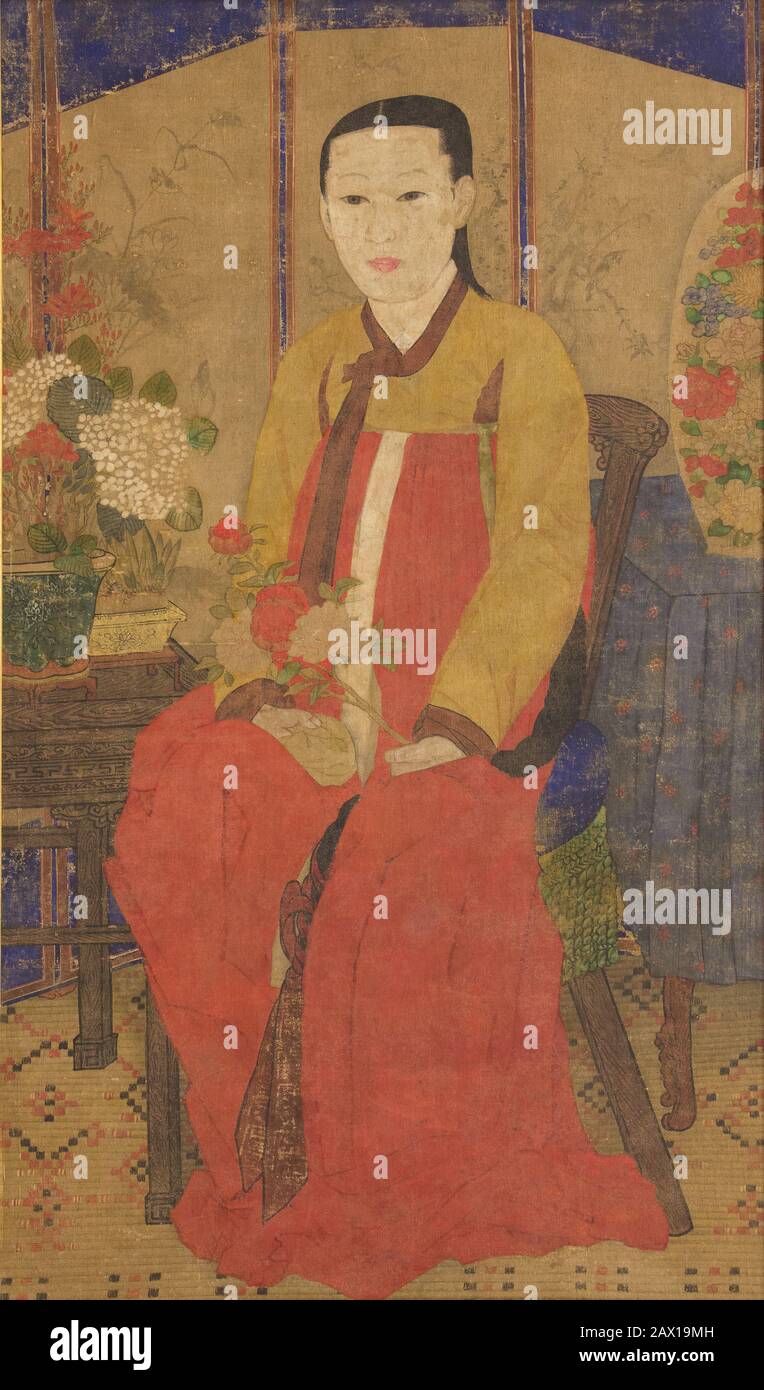 Portrait of a Woman, early 20th century (ca. 1920-40). Young unmarried woman wearing a traditional Korean dress (hanbok). Joseon dynasty (1392-1910). Stock Photohttps://www.alamy.com/image-license-details/?v=1https://www.alamy.com/portrait-of-a-woman-early-20th-century-ca-1920-40-young-unmarried-woman-wearing-a-traditional-korean-dress-hanbok-joseon-dynasty-1392-1910-image343007633.html
Portrait of a Woman, early 20th century (ca. 1920-40). Young unmarried woman wearing a traditional Korean dress (hanbok). Joseon dynasty (1392-1910). Stock Photohttps://www.alamy.com/image-license-details/?v=1https://www.alamy.com/portrait-of-a-woman-early-20th-century-ca-1920-40-young-unmarried-woman-wearing-a-traditional-korean-dress-hanbok-joseon-dynasty-1392-1910-image343007633.htmlRM2AX19MH–Portrait of a Woman, early 20th century (ca. 1920-40). Young unmarried woman wearing a traditional Korean dress (hanbok). Joseon dynasty (1392-1910).
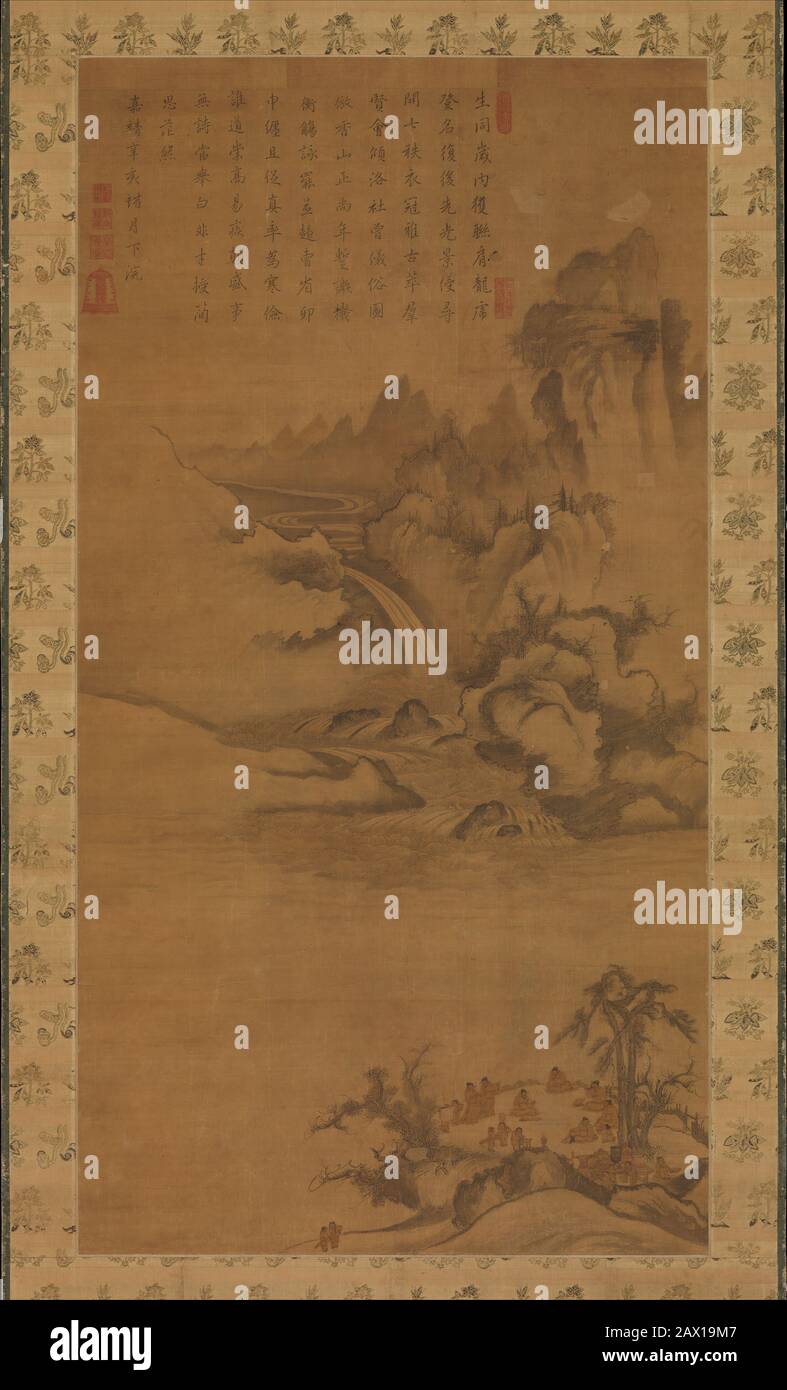 Gathering of government officials, ca. 1551. Reunion of government officials, written by Jeong Sa-ryong (1491-1570), they gathered to drink and recite poetry. Joseon dynasty (1392-1910). Stock Photohttps://www.alamy.com/image-license-details/?v=1https://www.alamy.com/gathering-of-government-officials-ca-1551-reunion-of-government-officials-written-by-jeong-sa-ryong-1491-1570-they-gathered-to-drink-and-recite-poetry-joseon-dynasty-1392-1910-image343007623.html
Gathering of government officials, ca. 1551. Reunion of government officials, written by Jeong Sa-ryong (1491-1570), they gathered to drink and recite poetry. Joseon dynasty (1392-1910). Stock Photohttps://www.alamy.com/image-license-details/?v=1https://www.alamy.com/gathering-of-government-officials-ca-1551-reunion-of-government-officials-written-by-jeong-sa-ryong-1491-1570-they-gathered-to-drink-and-recite-poetry-joseon-dynasty-1392-1910-image343007623.htmlRM2AX19M7–Gathering of government officials, ca. 1551. Reunion of government officials, written by Jeong Sa-ryong (1491-1570), they gathered to drink and recite poetry. Joseon dynasty (1392-1910).
 Amitabha Buddha’s assembly in the Western Paradise , late 18th-early 19th century. Surrounded by a supporting cast of twelve, including bodhisattvas, disciples, guardians, and attendants, including Avalokiteshvara and Kshitigarbha. Joseon dynasty (1392-1910) Stock Photohttps://www.alamy.com/image-license-details/?v=1https://www.alamy.com/amitabha-buddhax2019s-assembly-in-the-western-paradise-late-18th-early-19th-century-surrounded-by-a-supporting-cast-of-twelve-including-bodhisattvas-disciples-guardians-and-attendants-including-avalokiteshvara-and-kshitigarbha-joseon-dynasty-1392-1910-image343014261.html
Amitabha Buddha’s assembly in the Western Paradise , late 18th-early 19th century. Surrounded by a supporting cast of twelve, including bodhisattvas, disciples, guardians, and attendants, including Avalokiteshvara and Kshitigarbha. Joseon dynasty (1392-1910) Stock Photohttps://www.alamy.com/image-license-details/?v=1https://www.alamy.com/amitabha-buddhax2019s-assembly-in-the-western-paradise-late-18th-early-19th-century-surrounded-by-a-supporting-cast-of-twelve-including-bodhisattvas-disciples-guardians-and-attendants-including-avalokiteshvara-and-kshitigarbha-joseon-dynasty-1392-1910-image343014261.htmlRM2AX1J59–Amitabha Buddha’s assembly in the Western Paradise , late 18th-early 19th century. Surrounded by a supporting cast of twelve, including bodhisattvas, disciples, guardians, and attendants, including Avalokiteshvara and Kshitigarbha. Joseon dynasty (1392-1910)
 Gibbons in a Landscape, late 1800s or early 1900s. In contrast to the normal pairing of six-fold screens in Japanese culture, Korean screens are typically eight- or ten-fold, and are not linked as a pair. Also, Korean screens are traditionally mounted on raised "feet." The subject of this composition surely refers to a land of immortality, inhabited by gibbon families and a single white crane. Daoism and its cult of immortality enjoyed popularity during the Choson period, and lavish screens of this genre were produced for the imperial palace and court. and in aristocratic homes. Such Stock Photohttps://www.alamy.com/image-license-details/?v=1https://www.alamy.com/gibbons-in-a-landscape-late-1800s-or-early-1900s-in-contrast-to-the-normal-pairing-of-six-fold-screens-in-japanese-culture-korean-screens-are-typically-eight-or-ten-fold-and-are-not-linked-as-a-pair-also-korean-screens-are-traditionally-mounted-on-raised-quotfeetquot-the-subject-of-this-composition-surely-refers-to-a-land-of-immortality-inhabited-by-gibbon-families-and-a-single-white-crane-daoism-and-its-cult-of-immortality-enjoyed-popularity-during-the-choson-period-and-lavish-screens-of-this-genre-were-produced-for-the-imperial-palace-and-court-and-in-aristocratic-homes-such-image330093032.html
Gibbons in a Landscape, late 1800s or early 1900s. In contrast to the normal pairing of six-fold screens in Japanese culture, Korean screens are typically eight- or ten-fold, and are not linked as a pair. Also, Korean screens are traditionally mounted on raised "feet." The subject of this composition surely refers to a land of immortality, inhabited by gibbon families and a single white crane. Daoism and its cult of immortality enjoyed popularity during the Choson period, and lavish screens of this genre were produced for the imperial palace and court. and in aristocratic homes. Such Stock Photohttps://www.alamy.com/image-license-details/?v=1https://www.alamy.com/gibbons-in-a-landscape-late-1800s-or-early-1900s-in-contrast-to-the-normal-pairing-of-six-fold-screens-in-japanese-culture-korean-screens-are-typically-eight-or-ten-fold-and-are-not-linked-as-a-pair-also-korean-screens-are-traditionally-mounted-on-raised-quotfeetquot-the-subject-of-this-composition-surely-refers-to-a-land-of-immortality-inhabited-by-gibbon-families-and-a-single-white-crane-daoism-and-its-cult-of-immortality-enjoyed-popularity-during-the-choson-period-and-lavish-screens-of-this-genre-were-produced-for-the-imperial-palace-and-court-and-in-aristocratic-homes-such-image330093032.htmlRM2A5110T–Gibbons in a Landscape, late 1800s or early 1900s. In contrast to the normal pairing of six-fold screens in Japanese culture, Korean screens are typically eight- or ten-fold, and are not linked as a pair. Also, Korean screens are traditionally mounted on raised "feet." The subject of this composition surely refers to a land of immortality, inhabited by gibbon families and a single white crane. Daoism and its cult of immortality enjoyed popularity during the Choson period, and lavish screens of this genre were produced for the imperial palace and court. and in aristocratic homes. Such